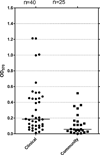Influence of isolate origin and presence of various genes on biofilm formation by Enterococcus faecium
- PMID: 24606170
- PMCID: PMC4562686
- DOI: 10.1111/1574-6968.12418
Influence of isolate origin and presence of various genes on biofilm formation by Enterococcus faecium
Abstract
Enterococcus faecium, a major cause of nosocomial infections, is often isolated from conditions where biofilm is considered to be important in the establishment of infections. We investigated biofilm formation among E. faecium isolates from diverse sources and found that the occurrence and amount of biofilm formation were significantly greater in clinical isolates than fecal isolates from community volunteers. We also found that the presence of the empfm (E. faecium pilus) operon was associated with the amount of biofilm formation. Furthermore, we analyzed the possible association between the distribution of 16 putative virulence genes and the occurrence of biofilm production. Even though the prevalence of these virulence genes was significantly higher in clinical isolates, we did not observe any correlation with the occurrence of biofilm formation.
Keywords: Enterococcus faecium; biofilm; virulence.
© 2014 Federation of European Microbiological Societies. Published by John Wiley & Sons Ltd. All rights reserved.
Figures

Similar articles
-
Characterization of the ebp(fm) pilus-encoding operon of Enterococcus faecium and its role in biofilm formation and virulence in a murine model of urinary tract infection.Virulence. 2010 Jul-Aug;1(4):236-46. doi: 10.4161/viru.1.4.11966. Virulence. 2010. PMID: 20676385 Free PMC article.
-
Differences in biofilm formation and virulence factors between clinical and fecal enterococcal isolates of human and animal origin.Microb Pathog. 2012 Jun;52(6):336-43. doi: 10.1016/j.micpath.2012.03.003. Epub 2012 Mar 15. Microb Pathog. 2012. PMID: 22445820
-
Virulence determinants in vancomycin-resistant Enterococcus faecium vanA isolated from different sources at University Hospital of Londrina, Paraná, Brazil.J Microbiol. 2010 Dec;48(6):814-21. doi: 10.1007/s12275-010-0099-5. Epub 2011 Jan 9. J Microbiol. 2010. PMID: 21221940
-
Optimizing future treatment of enterococcal infections: attacking the biofilm?Trends Microbiol. 2012 Jan;20(1):40-9. doi: 10.1016/j.tim.2011.11.001. Epub 2011 Dec 12. Trends Microbiol. 2012. PMID: 22169461 Review.
-
Evolution of virulence in Enterococcus faecium, a hospital-adapted opportunistic pathogen.Curr Opin Microbiol. 2018 Feb;41:76-82. doi: 10.1016/j.mib.2017.11.030. Epub 2017 Dec 9. Curr Opin Microbiol. 2018. PMID: 29227922 Review.
Cited by
-
Glycans affect DNA extraction and induce substantial differences in gut metagenomic studies.Sci Rep. 2016 May 18;6:26276. doi: 10.1038/srep26276. Sci Rep. 2016. PMID: 27188959 Free PMC article.
-
Architectural dissection of adhesive bacterial cell surface appendages from a "molecular machines" viewpoint.J Bacteriol. 2024 Dec 19;206(12):e0029024. doi: 10.1128/jb.00290-24. Epub 2024 Nov 5. J Bacteriol. 2024. PMID: 39499080 Free PMC article. Review.
-
Antibiotic Susceptibility Patterns, Biofilm Formation and esp Gene among Clinical Enterococci: Is There Any Association?Int J Environ Res Public Health. 2019 Sep 17;16(18):3439. doi: 10.3390/ijerph16183439. Int J Environ Res Public Health. 2019. PMID: 31533204 Free PMC article.
-
Correlation between biofilm formation and gelE, esp, and agg genes in Enterococcus spp. clinical isolates.Virulence. 2014 Jul 1;5(5):634-7. doi: 10.4161/viru.28998. Epub 2014 Apr 29. Virulence. 2014. PMID: 24782231 Free PMC article. No abstract available.
-
Enterococcus faecium: evolution, adaptation, pathogenesis and emerging therapeutics.Nat Rev Microbiol. 2024 Nov;22(11):705-721. doi: 10.1038/s41579-024-01058-6. Epub 2024 Jun 18. Nat Rev Microbiol. 2024. PMID: 38890478 Free PMC article. Review.
References
-
- Baldassarri L, Cecchini R, Bertuccini L, et al. Enterococcus spp. produces slime and survives in rat peritoneal macrophages. Med Microbiol Immunol. 2001;190:113–120. - PubMed
-
- Di Rosa R, Creti R, Venditti M, D'Amelio R, Arciola CR, Montanaro L, Baldassarri L. Relationship between biofilm formation, the enterococcal surface protein (Esp) and gelatinase in clinical isolates of Enterococcus faecalis and Enterococcus faecium. FEMS Microbiol Lett. 2006;256:145–150. - PubMed
-
- Donelli G, Guaglianone E. Emerging role of Enterococcus spp in catheter-related infections: biofilm formation and novel mechanisms of antibiotic resistance. J Vasc Access. 2004;5:3–9. - PubMed
Publication types
MeSH terms
Substances
Grants and funding
LinkOut - more resources
Full Text Sources
Other Literature Sources

